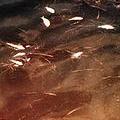 在1910年期間,當科學家開始研究所謂死區(dead zones)的低氧海洋地區時,世界上只有四個這樣的地區。而根據於8月15日出刊的最新一期《科學》期刊中的研究指出,如今全世界的海岸區一共有405個死區,總面積達到95000平方英里。由維吉尼亞海洋科學研究所的迪茲教授(Robert Diaz)所領導的全球性研究指出,死區的數量在1995到2007期間增加了三分之一。
在1910年期間,當科學家開始研究所謂死區(dead zones)的低氧海洋地區時,世界上只有四個這樣的地區。而根據於8月15日出刊的最新一期《科學》期刊中的研究指出,如今全世界的海岸區一共有405個死區,總面積達到95000平方英里。由維吉尼亞海洋科學研究所的迪茲教授(Robert Diaz)所領導的全球性研究指出,死區的數量在1995到2007期間增加了三分之一。
「死區曾經相當稀少,但是現在卻是司空見慣了。在更多的地方都能見到這樣的現象。」迪茲這樣表示。他的研究顯示,自從1960年代以來,世界各地死區的數量大約以每十年兩倍的速度增加。迪茲和瑞典哥德堡(Gothenburg)大學的羅森堡(Rutger Rosenberg)表示死區現在是「海洋生態系統的主要變數」,和以下這些因素排名在一起:「過度捕撈」、「棲地流失」和「全球環境問題引發的有害藻類過度生長」等問題。
死區的發生原因是過度的營養物質,大部分是氮和磷,進入海岸海域後變成海藻群的營養來源,當這些微小的植物死亡後沉到底層之後,又變成細菌的養分來源,在細菌分解的過程中則需要消耗周遭溶於水的氧分子。主要的營養物質包括農業肥料和石油燃燒後的剩餘物。
世界上最大的死區位於美國,在密西西比河河口,總面積超過8500平方英里,幾乎是紐澤西州的大小。該死區也涵蓋了切薩比克灣(Chesapeake)的主要幹道,每到夏天就會佔了約40%的面積,多達5%該區的水量。迪茲表示,地理證據顯示在切薩比克灣或是其他海口生態系裡,死區不是「自然發生的情形」,第一個發現切薩比克灣)裡的死區是在1930年代。
科學家將含氧量對魚類和其他生物太少的水域稱之為「低氧水域(hypoxic)」,迪茲說許多生態系都經歷從本來是週期性的低氧狀態到季節性,甚至當養分持續增加時,會延伸到持續性的低氧。地球上最大的死區,位在波羅的海,已經是長年性的低氧狀態了。大部分在切薩比克灣的河道都是季節性的夏季低氧水域的情形。
迪茲和羅森堡聲稱低氧的情形常常被忽略,直到它影響到人類所食用的生物為至止,低氧所帶來的負面效應就顯現在切薩比克灣有重要經濟地位的鱸魚上,班鱸魚身上慢性的細菌疾病蔓延和缺氧的底層水有相當的關係。數位切薩比克灣的研究學者,包含VIMS魚類病理學家佛格賓(Wolfgang Vogelbein),相信超過75%班鱸魚身上發現的分歧杆菌病mycobacteriosis流行疾病,是因為他們遇到了海灣的夏天死區,而被此環境壓力削弱了抵抗力。
死區形成時,班鱸魚被迫要從他們偏好較冷的底層水域移動到接進水面的暖水域。迪茲和羅森堡說低氧化所造成根本性的影響就是失去活力的海灣食物鏈。沒有了像是蚌類、蟲類等底層的生物,他們的天敵也失去了重要的食物來源。迪茲和羅森堡說減少死區的關鍵是「不要讓陸上的肥料進入到海裡」。對於付高價來購買和施作氮的農夫來說,這也是他們共同的目標。迪茲表示:「科學家和農夫必須一起努力,研發降低肥料由陸地上移往海洋的農作方法。」
Around 1910, when scientists began studying the marine areas of low oxygen known as dead zones, there were only four of them worldwide. Now, there are 405 dead zones in the world's coastal waters, covering a total area of 95,000 square miles, according to the latest research published today in the journal "Science." A global study led by Virginia Institute of Marine Science Professor Robert Diaz shows that the number of dead zones has increased by a third between 1995 and 2007.
"Dead zones were once rare. Now they're commonplace. There are more of them in more places," Diaz says. Worldwide, the number of dead zones has roughly doubled each decade since the 1960s, his research shows.
Diaz and collaborator Rutger Rosenberg of the University of Gothenburg in Sweden say that dead zones are now "the key stressor on marine ecosystems" and "rank with over-fishing, habitat loss, and harmful algal blooms as global environmental problems."
Dead zones occur when excess nutrients, primarily nitrogen and phosphorus, enter coastal waters and help fertilize blooms of algae. When these microscopic plants die and sink to the bottom, they provide a rich food source for bacteria, which in the act of decomposition consume dissolved oxygen from surrounding waters. Major nutrient sources include agricultural fertilizers and the burning of fossil fuels. The largest dead zone in the United States today, at the mouth of the Mississippi River, covers more than 8,500 square miles, an area roughly the size of New Jersey.
A dead zone also underlies much of the main channel of Chesapeake Bay, each summer occupying about 40 percent of its area and up to five percent of its volume. Geologic evidence shows that dead zones were not "a naturally recurring event" in Chesapeake Bay or most other estuarine ecosystems, says Diaz. The first dead zone in Chesapeake Bay was reported in the 1930s. Scientists refer to water with too little oxygen for fish and other active organisms as "hypoxic." Diaz says that many ecosystems experience a progression in which periodic hypoxic events become seasonal and then, if nutrient inputs continue to increase, persistent.
Earth's largest dead zone, in the Baltic Sea, is hypoxic year-round. Chesapeake Bay experiences seasonal, summertime hypoxia through much of its main channel. Diaz and Rosenberg note that hypoxia tends to be overlooked until it starts to affect organisms that people eat. A possible indicator of hypoxia's adverse effects on an economically important finfish species in Chesapeake Bay is the link between oxygen-poor bottom waters and a chronic outbreak of a bacterial disease among striped bass.
Several Chesapeake Bay researchers, including VIMS fish pathologist Wolfgang Vogelbein, believe that the high prevalence of mycobacteriosis, found in more than 75 percent of the Bay stripers, occurs because they are weakened by the stress of encountering the Bay's summertime dead zone. When the dead zone forms, it forces the stripers from the cooler bottom waters they prefer into warmer waters near the surface. Diaz and Rosenberg say an even more fundamental effect of hypoxia is the loss of energy from the Bay's food chain.
Without bottom-dwellers such as clams and worms, their predators lose an important source of nutrition. Diaz and Rosenberg say the key to reducing dead zones is "to keep fertilizers on the land and out of the sea." Farmers concerned with the high cost of buying and applying nitrogen to their crops share that goal. "Scientists and farmers need to continue working together to develop farming methods that minimize the transfer of nutrients from land to sea."says Diaz.
全文及圖片詳見ENS







